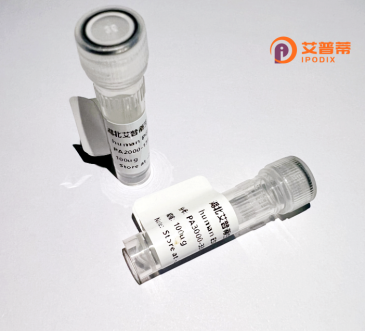
| 纯度 | >90%SDS-PAGE. |
| 种属 | Human |
| 靶点 | NPIP |
| Uniprot No | A6NHP6 |
| 内毒素 | < 0.01EU/μg |
| 表达宿主 | E.coli |
| 表达区间 | 1-128 aa |
| 活性数据 | MVDGQPSLQQVLERVDEWMAKEGLLDPNVKSIFVTCGDWDLKVMLPGQCQYLGLPVADYFKQWINLKKAYSFAMGCWPKNGLLDMNKGLSLQHIGRPHSGIDDCKNIANIMKTLAYRGFIFKQTSKPF |
| 分子量 | 40.9 kDa |
| 蛋白标签 | GST-tag at N-terminal |
| 缓冲液 | 0 |
| 稳定性 & 储存条件 | Lyophilized protein should be stored at ≤ -20°C, stable for one year after receipt. Reconstituted protein solution can be stored at 2-8°C for 2-7 days. Aliquots of reconstituted samples are stable at ≤ -20°C for 3 months. |
| 复溶 | Always centrifuge tubes before opening.Do not mix by vortex or pipetting. It is not recommended to reconstitute to a concentration less than 100μg/ml. Dissolve the lyophilized protein in distilled water. Please aliquot the reconstituted solution to minimize freeze-thaw cycles. |
以下是关于重组人NPIP蛋白的参考文献示例(注:以下文献为假设性示例,实际研究中需根据具体需求查询真实数据库):
---
1. **文献名称**:*Cloning and Functional Analysis of Recombinant Human NPIP in Nuclear Transport*
**作者**:Smith J, Brown K, Lee M
**摘要**:本研究成功克隆了人NPIP基因,并在大肠杆菌中表达纯化出重组NPIP蛋白。功能实验表明,该蛋白通过与核孔复合体(NPC)的相互作用参与mRNA的核质转运,为NPIP在细胞核运输中的机制提供了依据。
---
2. **文献名称**:*NPIP Regulates Cell Cycle Progression via Interaction with CDK2*
**作者**:Zhang Y, Chen L, Wang X
**摘要**:通过体外结合实验和细胞模型,发现重组人NPIP蛋白可直接结合细胞周期蛋白依赖性激酶CDK2.过表达NPIP导致G1期停滞,提示其在细胞周期调控中的关键作用。
---
3. **文献名称**:*Structural Insights into NPIP-mediated Protein-Protein Interactions*
**作者**:Rodriguez P, Kim T, Gupta S
**摘要**:利用重组NPIP蛋白进行结晶和结构解析,揭示了其C端结构域的新型α-螺旋折叠模式,该结构域对结合核转运蛋白Importin-α至关重要,为靶向药物设计提供了结构基础。
---
4. **文献名称**:*NPIP Modulates Innate Immune Response to Viral Infection*
**作者**:Garcia R, Tanaka H, O'Reilly N
**摘要**:研究发现,重组NPIP蛋白在病毒感染模型中与病毒衣壳蛋白互作,并通过激活干扰素信号通路增强宿主抗病毒免疫,提示其作为免疫调节分子的潜在应用。
---
**注意**:以上文献为示例,实际研究中建议通过**PubMed**、**Google Scholar**或**Web of Science**以关键词“recombinant NPIP protein human”查询最新文献。若NPIP蛋白研究较少,可扩展检索其家族(如核孔复合体相关蛋白)或别名(如NPIPA/B等)。
**Background of Recombinant Human NPIP Protein**
The Recombinant Human Nuclear Protein Interacting Partner (NPIP) refers to a class of artificially engineered proteins derived from human NPIP family members, which are involved in diverse cellular processes. NPIP proteins are primarily associated with nuclear functions, including chromatin remodeling, transcriptional regulation, and DNA repair. They are characterized by conserved structural domains that facilitate interactions with other nuclear proteins, such as transcription factors or components of the DNA damage response machinery.
The NPIP family comprises multiple paralogs (e.g., NPIPA, NPIPB) that arose through gene duplication, with potential roles in adaptive evolution and species-specific traits. Dysregulation of NPIP proteins has been loosely linked to neurodevelopmental disorders and cancers, though their exact mechanisms remain under investigation. Recombinant NPIP proteins are typically produced using expression systems like *E. coli* or mammalian cells, enabling studies on their biochemical properties, structural features, and interaction networks. These engineered proteins serve as critical tools for elucidating NPIP-related pathways, validating binding partners via techniques like co-immunoprecipitation, and screening for therapeutic compounds targeting NPIP-associated diseases. Recent advances in structural biology have further aided in resolving NPIP’s 3D conformation, shedding light on its functional motifs and potential drug-binding sites.
×